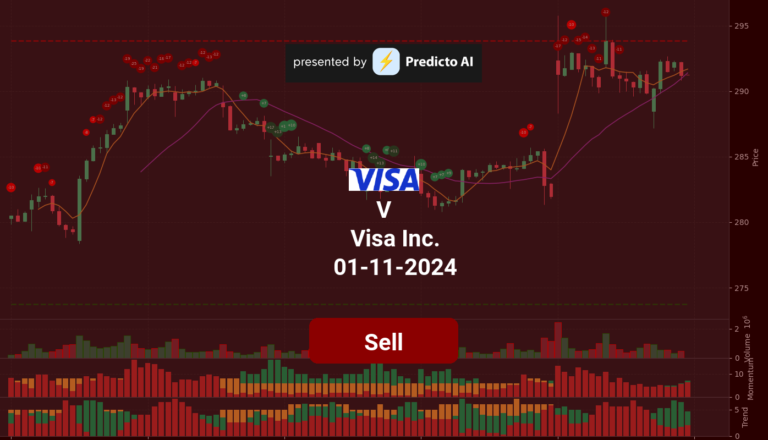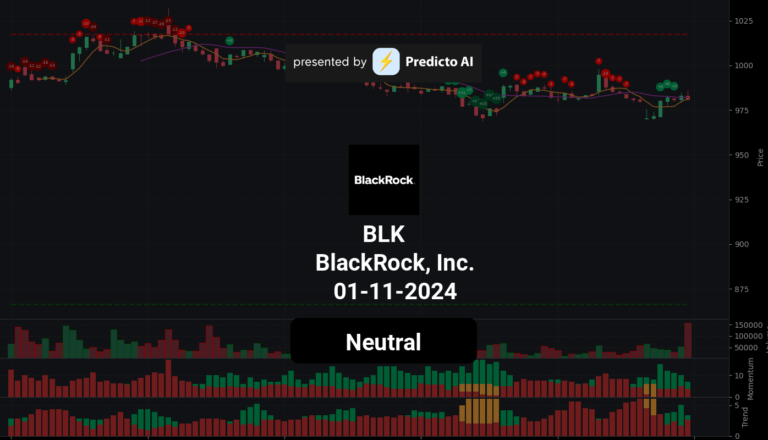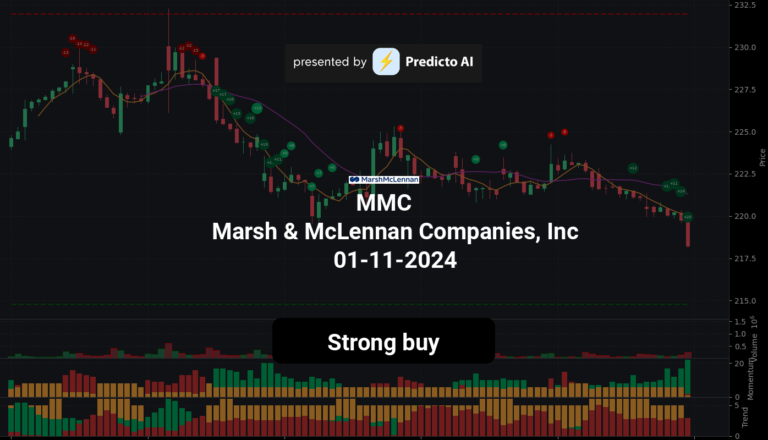WMB Stock Analysis: Strong Sell Signal!
🔴 Recommendation: WMB is currently flashing a Strong Sell signal, with a concerning mix of bearish indicators overshadowing its bullish trends.
📈 Key Highlights:
Price Trends: WMB’s stock price remains above both the 50-day EMA and 200-day EMA, indicating a bullish trend overall, yet significant resistance levels loom ahead.
Volume Indicators: The On-Balance Volume (OBV) is increasing, suggesting strong buying interest, but bearish divergence raises caution.
Analyst Upgrades: Recent upgrades from Morgan Stanley and Tudor Pickering Holt reflect a positive sentiment, despite mixed performance in the energy sector.
⚠️ Caution Flags:
Financial Health: A high Debt-to-Equity Ratio of 5.64 and a Current Ratio of 0.87 signal potential liquidity issues and significant financial risk.
Revenue Decline: Year-over-year revenue growth of -15.70% raises concerns about future profitability.
Insider Transactions: Low insider ownership at 0.41% and mixed insider transactions could indicate a lack of confidence from management.
Let’s dive into the details as we break down the price trends, indicators, financial health, valuation metrics, and more 👇
WMB Price Analysis

| Positive Momentum Signals | Negative Momentum Signals | Hold Momentum Signals |
|---|---|---|
|
|
| Positive Trend Signals | Negative Trend Signals | Hold Trend Signals |
|---|---|---|
|
|
|
WMB stock presents a challenging investment landscape, characterized by a mix of bullish trends and significant bearish signals. Currently, the stock is rated as a strong sell, indicating a cautious approach is warranted.
On the positive side, WMB shows some bullish trends, with the price consistently above both the 50-day EMA and the 200-day EMA, suggesting a bullish trend overall. Additionally, the Supertrend indicator confirms this bullish sentiment, as the price remains above the Supertrend line. The On-Balance Volume (OBV) is also increasing, supported by high volume, which typically indicates strong buying interest.
However, the stock faces considerable headwinds. The momentum indicators are predominantly negative, with the OBV showing bearish divergence and confirmation, alongside the StochRSI and RSI both indicating overbought conditions. This suggests that the stock may be due for a correction. Furthermore, there is a strong resistance level that could impede further price increases, adding to the caution investors should exercise.
In summary, while WMB has some positive trends, the overwhelming negative momentum indicators and strong resistance suggest that the stock may struggle to maintain its current levels. Investors are advised to approach with caution, and a strong sell recommendation is appropriate until clearer signals of recovery or growth emerge.
WMB Fundamental Analysis
WMB’s recent financial performance raises significant concerns for investors. The company reported a net income of $401 million for the most recent period; however, the year-over-year trend shows a troubling decline, which casts doubt on future profitability.
The financial health of WMB is further compromised by an extremely high debt-to-equity ratio of 5.64, indicating substantial financial risk and potential difficulties in managing its debt obligations. Additionally, a current ratio of 0.87 suggests that the company may struggle to meet its short-term liabilities, raising liquidity concerns. The cash to total assets ratio of 0.02 highlights limited financial flexibility, making WMB vulnerable to economic downturns.
Valuation metrics also point to potential overvaluation, with a forward P/E ratio of 23.70 and a price-to-sales ratio of 6.00, both suggesting that the stock may be priced too high relative to its earnings and revenue generation capabilities.
In terms of growth and profitability, WMB has experienced a significant year-over-year revenue decline of 15.70%, which could negatively impact its stock price. Despite this, the company boasts an impressive operating margin of 105.52%, indicating efficient operations and good cost control. Furthermore, a net profit margin of 17.17% reflects the company’s ability to generate profits after expenses, showcasing some level of profitability despite the revenue decline.
Shareholder information reveals potential concerns, as the average dilution earnings of $401 million may affect earnings per share. The company’s stock repurchases of approximately $46.33 million are not substantial enough to significantly influence share value.
On the balance sheet, WMB’s average net debt of $24.83 billion raises alarms about its financial flexibility and ability to service debt obligations. The high debt-to-equity ratio of 178.10 further indicates a risky financial structure that could be problematic during economic downturns. The average total debt of $25.93 billion necessitates further analysis to understand its implications on financial health.
Cash flow analysis shows some positive signs, with an average capital expenditure of $1.843 billion suggesting that the company is investing in growth and expansion. Additionally, positive net cash from financing activities of $4.702 billion indicates that WMB is raising capital, which could be utilized for growth initiatives or debt reduction.
Overall, the combination of declining revenue, high debt levels, and liquidity concerns leads to a strong sell recommendation for WMB. Investors should exercise caution and thoroughly evaluate the company’s ability to navigate its financial challenges before considering any investment.
Financial Health
🔴 Net Income for the most recent period was $401 million, but the year-over-year net income trend shows a decrease, raising concerns about future profitability.
🔴 The Debt-to-Equity Ratio is extremely high at 5.64, indicating significant financial risk and potential challenges in managing debt.
🔴 Current Ratio is 0.87, suggesting potential liquidity issues, as the company may struggle to meet short-term obligations.
🔴 Cash to Total Assets Ratio is low at 0.02, indicating limited financial flexibility and vulnerability to economic downturns.
Valuation
🔴 Forward P/E ratio of 23.70 suggests the stock may be overvalued relative to its earnings potential.
🔴 Price-to-Sales Ratio of 6.00 is high, indicating potential overvaluation compared to revenue generation.
Growth and Profitability
🔴 Year-over-year revenue growth of -15.70% indicates a significant decline in revenue, which could negatively impact stock price.
🟢 Operating Margin of 105.52% suggests efficient operations and good cost control, which is a positive sign.
🟢 Net Profit Margin of 17.17% reflects the company’s ability to generate profits after expenses, indicating some level of profitability despite revenue decline.
Shareholder Information
🔴 Average Dilution Earnings of $401 million could indicate potential concerns for shareholders regarding earnings per share.
🔴 Stock Repurchases of approximately $46.33 million may not be substantial enough to significantly impact share value.
Income Statement
🔴 Total revenue for the most recent period was $2.336 billion, with a concerning year-over-year revenue decline.
🟢 The net profit margin of 17.17% is strong, reflecting the company’s ability to generate profits after all expenses.
Balance Sheet
🔴 Average Net Debt of $24.83 billion raises concerns about financial flexibility and the ability to service debt obligations.
🔴 The high Debt-to-Equity Ratio of 178.10 indicates a risky financial structure that could be problematic in economic downturns.
🔴 Average Total Debt of $25.93 billion requires further analysis to understand its impact on financial health.
Cashflow
🟢 Average Capital Expenditures of $1.843 billion suggest the company is investing in growth and expansion, which is a positive indicator.
🟢 Positive net cash from financing activities of $4.702 billion indicates the company is raising capital, which could be used for growth or debt reduction.
Overall, the combination of declining revenue, high debt levels, and liquidity concerns leads to a strong sell recommendation for WMB.
WMB News Analysis
WMB News: A mixed outlook with positive adjustments and market positioning.
Summary of WMB news indicates a generally positive sentiment towards Williams Companies (WMB), driven by upgrades from analysts and favorable market conditions. However, there are concerns regarding the overall performance of energy stocks, which could impact WMB’s growth. Investors should weigh the positive analyst ratings against the broader market trends.
🟢 Morgan Stanley upgraded Williams Companies to Overweight from Equalweight, raising the price target to $58 from $52. This upgrade reflects confidence in WMB’s potential for growth and suggests a bullish outlook from a reputable financial institution.
🟢 Tudor Pickering Holt also adjusted its price target on WMB to $46 from $43, indicating a positive adjustment in expectations for the stock.
🔴 However, Zacks reported that oil and energy stocks, including WMB, are lagging behind some peers like Western Midstream Partners (WES) this year, which raises concerns about competitive performance.
🟢 The article discussing pipeline stocks suggests that WMB, along with KMI and ENB, is well-positioned to thrive in a volatile energy market, indicating resilience and potential for growth.
🟢 The AI boom is expected to fuel gas demand, which could benefit WMB and similar pipeline stocks, suggesting a favorable market environment for the company.
🔴 Goldman Sachs maintained a Neutral rating on WMB while adjusting the price target to $45 from $44, indicating a cautious approach despite the positive adjustments from other analysts.
WMB Holders Analysis
The financial health of WMB indicates a generally positive outlook, but caution is warranted due to mixed signals from insider transactions and the low insider ownership.
🟢 WMB has a high institutional ownership at **88.40%**, which reflects strong interest from large investors. This suggests confidence in the company’s long-term prospects and provides stability against market volatility.
🟡 The insider ownership is very low at **0.41%**, indicating a potential lack of confidence from management. This could lead to concerns about the alignment of interests between management and shareholders.
🟡 Recent insider transactions show a mix of sales and purchases, with a total of **60,266 shares purchased** and **42,200 shares sold** in the last six months. While there are more purchases than sales, the overall low level of insider ownership raises questions about management’s confidence in the stock.
🟢 The number of institutional holders is substantial at **1,685**, indicating a diversified ownership structure that can help mitigate risks associated with individual investors selling off their shares.
🔴 The recent insider transactions include significant sales, which could signal a lack of confidence or a need for liquidity among executives. This is a point of concern for potential investors.
WMB Analyst Ratings
The analyst ratings for WMB show a generally positive outlook, with a notable number of analysts recommending either a buy or strong buy. Recently, Morgan Stanley upgraded its rating from Equal-Weight to Overweight, which is a significant positive indicator. 🟢 In the past month, there have been 6 strong buy ratings, 8 buy ratings, 5 hold ratings, and no sell or strong sell ratings. This suggests a bullish sentiment among analysts.
However, the slight increase in hold ratings over the past months indicates some caution. The overall sentiment remains positive, but the medium confidence level reflects potential volatility in the market.
WMB Economic Analysis
Based on the US economic and market data:
🟢 The recent Non-Farm Payroll data shows an increase in employment, with 158,445 jobs added in July, indicating a strengthening labor market. This is generally positive for energy demand, which can benefit WMB as an energy infrastructure company.
🟢 The unemployment rate has slightly increased to 4.3%, but it remains relatively low, suggesting that the labor market is still healthy. A stable labor market can lead to increased energy consumption, supporting WMB’s operations.
🟡 Retail sales have shown a slight increase, which is a positive sign for consumer spending. However, the growth is modest, and any significant slowdown could impact energy demand.
🔴 The CPI data indicates inflationary pressures, which could lead to higher operational costs for WMB. If inflation continues to rise, it may affect profit margins, especially if the company cannot pass on costs to consumers.
🟢 The overall economic indicators, including GDP growth and commodity prices, suggest a stable environment for energy companies. The GDP growth of 2.9% year-over-year is encouraging, as it typically correlates with increased energy consumption.
In summary, while there are some concerns regarding inflation and its potential impact on costs, the overall economic environment remains supportive for WMB. The company’s strong position in the energy infrastructure sector, combined with positive employment data, suggests a favorable outlook for the next month.
Disclaimer
Investors may consider the AI predictions and news summaries as one factor in their investment decisions alongside their own research and risk tolerance.




